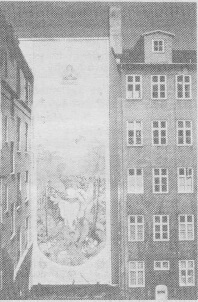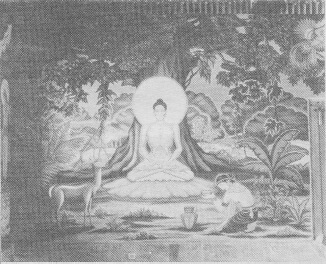| The following article is from the Summer, 1990 issue of the Snow Lion Newsletter and is for historical reference only. You can see this in context of the original newsletter here. |
Inspired by her two daughters, her Swedish origins and a predilection for the symbolism and spiritualism of the East, Marianne Rydvald creates huge fanciful murals that reach out to many people and not just to a few.
It is from the wisdom of the East and the mythology of the North-Buddha's teachings and Swedish naturethat Marianne draws her inspiration. Her indoor and outdoor murals are full of marvelous details and joy, and shine like fanciful sagas. This Swede from the rural north has wandered and worked in India, Nepal, Mexico, Canada and the United States.
Today Marianne, with her two daughters and son, lives in Copenhagen part of the year. It's a stop along the way, she calls it. Exactly where she is headed she doesn't know. But she must travelto gather impressions and to experience, feel and see what is strange and unknown. This is what she loves and what she likes to weave into her art.
Marianne never intended to become a painter. Sure, she had painted and drawn all through her childhood, but it was singing that she really wanted to study. So when she completed her schooling up north she set off for Stockholm for voice lessons. She went to music school and also did a lot of theater acting. That was in the 1960s.
Marianne first came in contact with murals in Mexico. She saw Diego Rivera's color explosions on house gables and began hoping that it was a mural painter she would one day become. Rivera depicted the early history of Mexicothe Indians and the conquistadoresand when she herself came to live in an Indian town she started to paint on large canvases.
When Marianne returned to Stockholm after a few years' absence she studied mural painting at the Academy of Fine Arts. I learned the old fresco technique that the Renaissance painters used, and wanted nothing more than to set out in the world to decorate drab walls and house gables. But where? In Sweden it was something new and unknown. The only commission she received was from a printer in Stockholm.
Together with a group of friends, Marianne then took off for India. She had been longing to go for years and was not disappointed. It was the Great Adventure.
Marianne was fascinated by the different ways of thinking and living and she studied the teachings of the Buddha and came into contact with Tibetan monks. A new world opened up for herso different from her Western one.
Marianne has been to India several times and her art is an amalgamation, a synthesis of the fairy-tale world and troll-like nature of her childhood and the symbolism and spiritual world of the East. In her paintings you see these worlds side by sidea Swedish girl in a Nordic summer garden side by side with a Buddha figure; an Indian elephant in a Scandinavian saga-setting; lions, flowers and Swedish child-like dreams where fantasy, love and peace are self-evident.

Copenhagen mural
The disadvantage with being a mural painter, says Marianne, is that you have to get used to the fact that private persons don't have the financial means or the motivation to invest in paintings they cannot sell, and that communities seldom have the funds to commission paintings of this type.
The tallest mural that Marianne has painted is entitled The Long Journey, and is in a courtyard in Copenhagen. Commissioned by a ship owner, it measures 24 meters high by 7 meters in breadth. It took her a month and a half to paint. I started at the ground and, balancing on ladders and scaffolds, I worked my way up meter by meter until I reached the top under the ridge of the roof, she relates. Instead of a sad, gray wall there is now a large white elephant surrounded by flowers and tropical trees.
A few years ago Marianne was in California. Friends had told her that the cultural climate there was open and inspiring and that outdoor murals were especially appreciated. It was absolutely fantastic to be confronted by a milieu that had the feeling for murals. On many houses there were murals in real strong colors and I often reflected that this is how art should function. Marianne painted two murals in Los Angeles and one in Mendocino County. At a peace conference she also painted a large canvas that UNESCO hung in a children's hospital in Los Angeles.
Marianne has now painted many murals (she recently completed one for the International Year of Tibet art show at the Asian Art Museum in Golden Gate Park-see article this issue). Probably one of the most monumental murals she has created is in Bodhgaya, India. Beru Khyentse Rinpoche, a teacher of the Karma Kagyu lineage, met with Marianne in 1983 while the Rinpoche was in the middle of constructing Karma Tharjay Chokhorling Monastery. Marianne had just completed two portraits of the late Ven. Kalu Rinpoche and when Beru Khyentse Rinpoche saw them he commissioned her to decorate the main temple of the monastery.
On three of the walls fifty-five meters in total length and five meters high, Marianne painted the sixteen main events of the Buddha's life starting with a scene of the Buddha's mother sleeping on lotuses on a lake dreaming of a white elephant. Visitors to Bodhgaya should make it a point to see this grand work.
Marianne Rydvald is a community artist. Her art speaks to people and uplifts them as they trundle through their daily lives. Their message is always a spiritual and cosmopolitan one; they portray figures and landscapes from diverse traditions and cultures often blended in a single harmonious vision. Marianne's inspiration comes directly from her experience of living, working and travelling in different cultures. She has spent thousands of hours staring at walls in Europe, Latin America, India and elsewhere, reflecting on the spirit of the people for whom these walls were painted. She has developed a style that is markedly her own, one that has the power to both calm and enliven the mind.
If you would like to contact Marianne, please write to the editors at Snow Lion.

Mural at Karma Tharjay Chokhorling Monastery

